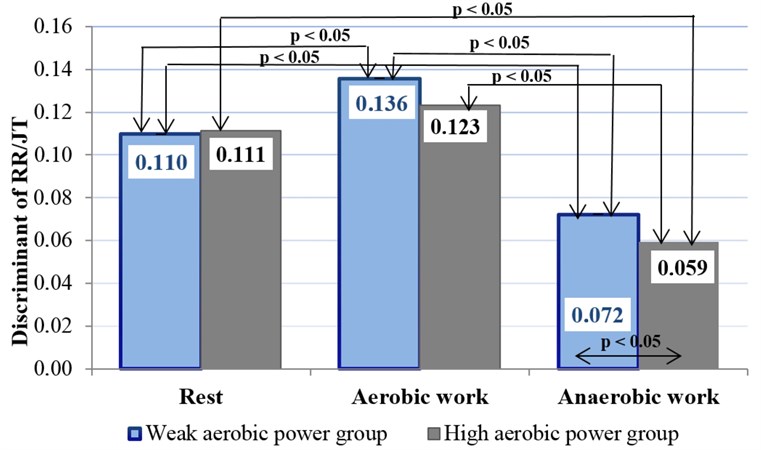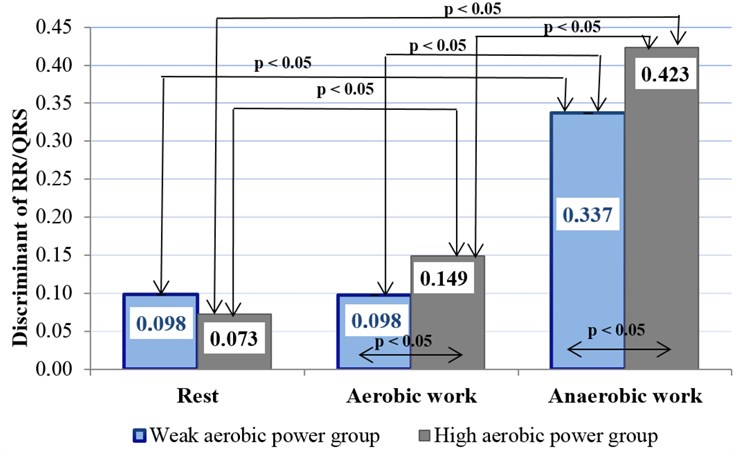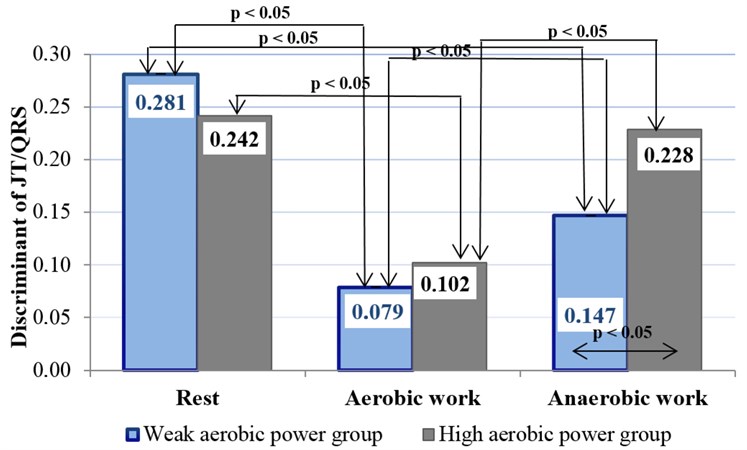Abstract
The analysis of electrocardiographic parameters concatenations can be used to describe physiological changes in the whole body during physical load. Research aim was to analyse dynamical characteristics of electrocardiographic parameters in different physical ability men group during bicycle ergometry. The research contingent consisted of 63 healthy men, who according to the power achieved at the anaerobic threshold were divided into 2 groups. The following tests were used: anthropometric measurements, electrocardiography, bicycle ergometry, spiroergometry and mathematical statistics. During bicycle ergometry the pulmonary gas exchange rates were collected, which was used to establish the anaerobic threshold. This research has shown changes in the functional parameters of the cardiovascular system and inter-parametric concatenations of different fractal levels between aerobic and anaerobic work. This study established that the best results were obtained in the high aerobic power group. This research established that the functional parameters of the cardiovascular system depended on physical ability of the subjects. In the high aerobic power group, the body metabolism and regulatory systems (JT/QRS) and heart and body (RR/QRS) interaction was weaker, and the heart metabolism and regulatory systems (RR/JT) interaction was stronger than in other research group (p< 0.05) during physical load.
1. Introduction
Peculiarities and opportunities of human adaptation to physical load are relevant tasks of physiology, sports and clinical medicine [1]. There are many research works which emphasize the unity of the body functions [2], synergic interaction [3] and show informative advantages of complex, integral and integrated assessments [4]. The further progress of medical diagnostic technologies is unthinkable without the development and usage of non-linear analysis methods based on chaos and complex systems theories [5]. In sports medicine and clinical practice one of the most popular tests of the body adaptation to physical load is bicycle ergometry test. The most common diagnostic tool which reflects a cardiac function is an electrocardiogram (ECG). It is a simple non-invasive method and the ECG parameters can be used to describe the physiological changes in the whole body [6]. Such studies will allow evaluating the changes of the body complexity during various interventions, identifying differences of body reactions in groups of different physical ability, and selecting suitable physical workload.
An anaerobic threshold has been an important index of performance for assessing cardiopulmonary and muscle integration during aerobic exercise [7]. Scientific research has shown that it is important to choose an optimal physical exercise by establishing anaerobic threshold (AT), because above this level exhaustion and intramuscular pain are caused [8]. Usually AT is estimated by using either ventilatory measures (ventilatory threshold) or blood lactate measures (lactate threshold) [9]. In our research we used ventilatory measurement.
The aim of the study was to analyse dynamical characteristics of electrocardiographic parameters in different physical ability men group during bicycle ergometry.
2. Methods
2.1. Research subjects
The investigated contingent consisted of 63 men, who volunteered to participate in this study (characteristics are presented in Table 1). The healthy men were divided into 2 groups according to the power level reached at the anaerobic threshold (in a weak aerobic power group (WAPG) the average of anaerobic threshold was 183.33±3.38 W (n= 33) and in a high aerobic power group (HAPG) the average of anaerobic threshold was 247.73±3.50 W (n= 30)) (p<0.05). Initially, the data were collected from 72 weeks, but 9 cases were withdrawn from the final analysis due to the data failure. The subjects were informed about the experimental procedures to which they would be submitted and signed the informed consent form before taking part in the study. The volunteers were free to withdraw from the study at any time without any consequences. The study was approved by the Regional Ethics committee.
Table 1Characteristics of the investigated contingent
The research group | Weak aerobic power group (n= 33) | High aerobic power group (n= 30) | Statistical difference |
The average of anaerobic threshold (W) | 183.33 ± 3.38 | 247.73 ± 3.50 | p<0.05 |
Age (m) | 45.93 ± 2.31 | 40.93 ± 1.70 | p>0.05 |
Body mass index (kg/m2) | 25.03 ± 0.42 | 24.46 ± 0.37 | p>0.05 |
The following methods were used in the research: anthropometric measurements, electrocardiography, blood pressure measurement, bicycle ergometry, spiroergometry and mathematical statistics. During bicycle ergometry the pulmonary gas exchange rates were collected, which was used to establish the anaerobic threshold.
2.2. Experimental protocol
All subjects completed a form about their health condition before participating in the research. Their anthropometric measurements (i. e. height, weight) were carried out. The subjects were familiarized with the experimental environment and the research personnel. After the initial measurements had been done, the participants without warm-up performed a computerized bicycle exercise stress test. A short-term provocative research protocol was used. The initial workload performed by all subjects was 50 W, and it was increased by 25 W every minute up to reaching sub-maximal power. The frequency of pedalling was 60 rotations/min. During the test electrocardiographic and pulmonary gas exchange parameters were synchronically and continuously registered during the whole bicycle ergometry test. Ventilatory variables were obtained through a computer-aided spiroergometric measurement system. The device presents the power values (W), oxygen consumption (VO2), carbon dioxide production (VCO2), minute ventilation (VE) and heart rate (HR) applied at the exact time. The respiratory exchange ratio (RER) was also calculated and recorded in the research. The power applied to the cycle ergometer during exercise protocols was controlled by the system through an interface with the bicycle. The anaerobic threshold was established by the pulmonary gas exchange rate (O2/CO2), when the increased alveolar CO2 output relative to O2 uptake and registered respiratory exchange ratio (RER) were above 1.
The computerized electrocardiographic registration and the analysis system “Kaunas-Load”, developed at the Institute of Cardiology of Lithuanian University of Health Sciences, were used for evaluating a functional state of the cardiovascular system. ECG parameters were measured for each cardio cycle. The durational ECG parameters assessed were: duration of RR interval (ms) (RR), duration of JT interval (ms) (JT) and duration of QRS interval (ms) (QRS). Selected ECG parameters represent different fractal levels of the body: RR and JT describe systemic, QRS – cardiac intrinsic regulatory processes. New nonlinear analysis methods, such as second order matrix analysis, were used for concatenations evaluation. Concatenations which represent interactions of components of various body systems and changes according to the integration evaluation model were assessed: discriminant between RR and JT parameters (RR/JT), discriminant between RR and QRS parameters (RR/QRS), discriminant between JT and QRS parameters (JT/QRS).
2.3. Data processing and statistical analysis
The data were analysed using SPSS 16.0 for Windows programme. The Mann – Whitney test was applied for comparison of two independent samples. The alpha level of p< 0.05 was required for statistical significance. Group data are presented as mean (m) ± standard error of the mean (SEM). The parameters were rated by the maximum and minimum value.
3. Results
Analysing concatenation of ECG parameters, it was established that the heart metabolism and regulatory systems (RR/JT) interaction was stronger in HAPG than in WAPG (p< 0.05) (Fig. 1) during aerobic and anaerobic work. This shows strengthening of functional links between regulatory and supplying systems at the systemic level in the better physical ability group.
Fig. 1Discriminant of concatenation between RR and JT parameters during bicycle ergometry. Note: p< 0.05 – statistical difference between groups

A concatenation between RR and QRS parameters reflects connection between the two levels of regulatory systems (body and organ levels) (Fig. 2). This index in HAPG was weaker than in WAPG (p< 0.05) during aerobic and anaerobic work, so the better regulations between heart and body were in lower physical ability groups.
JT/QRS in the high aerobic power group was weaker than in other research group (p< 0.05) during aerobic and anaerobic work (Fig. 3). Based on our research results it can be said that the body metabolism and regulatory systems concatenations depended on physical ability and it decreased in HAPG.
Fig. 2Discriminant of concatenation between RR and QRS parameters during bicycle ergometry. Note: p< 0.05 – statistical difference between groups


Fig. 3. Discriminant of concatenation between JT and QRS during bicycle ergometry. Note: p<0.05 – statistical difference between groups
4. Discussion
The purpose of this study was to analyse dynamical characteristics of electrocardiographic parameters in different physical ability men group during physical load. The bicycle ergometer test was used in our investigation and it engaged a large muscle mass. Due to this reason Papievienė et al. (2014) assumed the important role of the functional capacity of the cardiovascular system during physical load [10]. This research also has shown changes in functional parameters of a cardiovascular system, i. e. the electrocardiographic parameters, and changes of inter-parametric concatenations (complexity) of different fractal levels during aerobic and anaerobic work. We demonstrated that the best results were shown in the high aerobic power group.
We are aware that our study has limitations, particularly with regard to the small sample size and the constrained characteristics of our study population, which prevented from the evaluation of factors such as age and level of fitness, each of which is known to influence the variables of interest. Also, we are aware that the choice of a rapid work rate incremental protocol may have influenced the results utilized, i. e. different results may be observed if a slower work rate increment protocol is used. We took precautions to limit errors in the calibration procedures, with all equipment being calibrated before each test and all tests being performed. Thus, our investigation should be considered as a pilot study conducted at extreme altitude, with the conclusions only being applicable to healthy untrained adults.
This study of ECG parameters and their concatenations with the help of new mathematical methods of analysis opens new opportunities for practical application of complex systems theory in order to reveal the changes during aerobic exercise.
5. Conclusions
In this research it was established that the functional parameters of the cardiovascular system depended on physical ability of the subjects. In the high aerobic power group, the body metabolism and regulatory systems (JT/QRS) and heart and body (RR/QRS) interaction was weaker, and the heart metabolism and regulatory systems (RR/JT) interaction was stronger than in other research groups (p< 0.05) during physical load.
References
-
Vainoras A., Šmidtaitė R., Bikulčienė L., Gargasas L. Monitoring of elderly using special matrix characteristics for analysis of ECG parameters. Proceedings of International Conference Biomedical Engineering, 2011, p. 26-29.
-
Šmidtaitė R., Navickas Z., Vainoras A., Bikulčienė L., Poškaitis V. Evaluation of coherence of t-wave in different leads. Electronics and Electrical Engineering, Vol. 5, Issue 93, 2009, p. 113-116.
-
Bikulčienė L., Venskaitytė E., Jaruševičius G. The estimation of human vital signs complexity. International Journal of Medical, Pharmaceutical Science and Engineering, Vol. 8, Issue 1, 2014, p. 39-44.
-
Žumbakytė-Šermukšnienė R., Kajėnienė A., Berškienė K., Daunoravičienė A., Sederevičiūtė-Kandratavičienė R. Assessment of the effect of anthropometric data on the alterations of cardiovascular parameters in Lithuanian elite male basketball players during physical load. Medicina, Vol. 48, Issue 11, 2012, p. 566-571.
-
Berškienė K., Navickas Z., Vainoras A. Heart rate complexity changes during bicycle ergometry. 18th Annual Congress of the European College of Sport Science: Book of Abstracts, p. 612.
-
Slapšinskaitė A., Vainoras A., Bikulčienė L. The analysis of ECG complexity during a bicycle ergometry test. Technologies of Computer Control, Vol. 14, 2013, p. 59-65.
-
Burnley M., Jones A. M. Oxygen uptake kinetics as determinant of sports performance. European Journal of Sport Science, Vol. 7, Issue 2, 2007, p. 63-79.
-
Reilly T., Ekblom B. The use of recovery methods post-exercise. Journal of Sports Sciences, Vol. 23, Issue 6, 2005, p. 619-627.
-
Stedman T. L. Medical dictionary for the health professions and nursing. Walters Kluwer Health/Lippincott Williams & Wilkins, 2012, p. 2339.
-
Papievienė V., Poderienė K., Trinkūnas E., Grūnovas A., Poderys J. Cardiac function and muscular oxygen desaturation in sprint and endurance cohorts during the incremental bicycle ergometry. Baltic Journal of Sport and Health Sciences, Vol. 1, Issue 92, 2014, p. 49-54.
